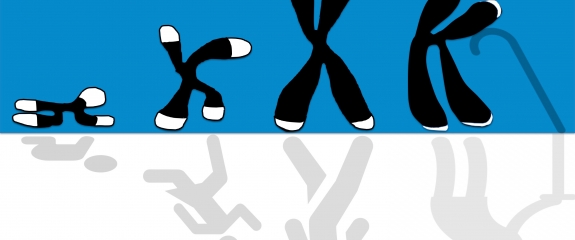Tantalising telomeres

Many scientists believe that we have reached the end of the life-expectancy revolution we have witnessed over the last 150 years. It is now proposed that we should now focus on managing the disease and frailty that haunt our sunset years. Others however believe that a better understanding of the biological processes that mark cellular ageing will result in our ability to reignite the lifespan modification revolution.
In this brief series by taking a snapshot of current development in the science of ageing we mark the conclusion of the clinical phase of the MID-Frail study, which is looking at ways of modifying disease in old age, and also the first phase of the Frailomic initiative, investigating inherent markers for the development of frailty. Both initiatives are funded by multimillion Euro grants from the European FP7 Framework and are being run by Niche Science & Technology Ltd.
If you are wondering how your cells age, look no further than the ends of your chromosomes. Special structures called telomeres are stretches of DNA and proteins at the ends of our chromosomes. When a cell divides, chromosomes are replicated and each daughter cell inherits an identical pair. However, our cells have a problem with replicating DNA. Although the enzymes that moderate the process, DNA polymerases, easily replicate one of the DNA strands in the chromosome, replication of the other strand is much more complex. Being ‘directional’ in nature, with the two strands of the double helix running in opposite directions, the polymerases readily produce a continuous strand of DNA going in one direction but find it more complex in the other. To avoid getting itself in a tangle short fragments are produced in the forward direction, which are then joined together by other enzymes. When it comes to the far ends of our chromosomes, the very last stretch of the reverse, or lagging, strand cannot be replicated. Scientists call this the "end replication problem." The result of this is a progressive shortening of the telomere DNA stretch with every round of cell division.
Telomere shortening also means that one strand of DNA is slightly longer than the other. This is actually a good thing; it allows the free DNA strand to curl and tuck into the existing double-stranded DNA, forming a protective loop. When telomere length reaches a particular cut-off point, the cell becomes senescent, meaning that it can no longer divide and will subsequently die.
As a consequence of the relationship of cell viability and telomere length it has been proposed that length can be used to indicate an individual's ‘biological age’ (which can be very different from their chronological age). As part of the FP7-funded Frailomic initiative the company Life Length is looking at how telomere length relates to frailty, one of the major markers of biological age, in the elderly. In our recent series on ageing we published a video describing the work done and the science behind Life Length. We know that many factors - including physical exercise, sleep, depression, and certain gene mutations - are associated with reduced telomere length, and, by extension, can lead to premature biological aging. Telomeres are believed to keep a close eye on the damage that accumulates in our cells and signal when it is time for them to retire.
Whether telomere length is a marker of biological aging or a cause of it remains to be confirmed but limiting the factors that are negatively associated with telomere length is likely to contribute to a more youthful biological age. This forms the core of the hypothesis proposed by molecular biologist Elizabeth Blackburn, who shared a Nobel Prize for her research on telomeres. Promoted in the recent book “The Telomere Effect,” is the idea that you have more control over your own aging than you may imagine. You can actually lengthen your telomeres — and perhaps your life — by following sound health advice, the authors argue, based on a review of thousands of studies.
Researchers from the Centers for Disease Control and Prevention looked at the telomeres from nearly 6,000 adults enrolled in a multi-year survey. People were asked what physical activities they had done in the past month and how vigorously they did them. They also provided DNA samples, from which the researchers measured telomere length. After adjusting for smoking, obesity, alcohol use, gender, race and other factors, it was found that people who exercised the most had significantly longer telomeres than those who were sedentary. The most sedentary people had 140 fewer base pairs of DNA at the ends of their telomeres, compared to the most active: believed to represent a difference of about 9 years of cellular aging. Subjects were graded by the amount of exercise they reported and to qualify as top-tier exercisers, people had to do the equivalent of at least 30—40 minutes of jogging a day 5-days-a-week. Doing less was also linked to aging benefits, but they were not as powerful. The study relies on self-reported physical activity and was only able to show an association — not a cause-and-effect relationship—between exercise amount and telomere length.
One challenge with telomere research is that most studies measure the length of telomeres in blood cells. However, we’re not all one age throughout our bodies, it may be that your liver is aging faster or slower than your blood. It is also most likely that parts of you that are the ‘oldest’ biologically that are likely to cause problems first. In addition, measuring telomere length in the blood is thought to reflect the biological age and (consequently) capacity of immune stem cells to function well and not the age of cells in your liver, for example.
It is not clear whether the methods are quantitative enough or provide sufficient resolution to predict your biological age from the length of your telomeres. However, its value as a biomarker of health outcomes will be better qualified when the results of the Frailomic initiative are reported. In the words of Dr Stephen Matlin, CEO of Life Length, “Being able to adopt lifestyle and therapeutic interventions that slow our ageing seems very viable but for that we need to be able measure the effects. For that, telomere length is a diagnostic test that gives us insight to our rate of ageing.” While there’s no guarantee that people with longer telomeres will live longer, healthier lives, the indications are certainly in favour of adopting a healthy lifestyle if you want to live longer. It seems reasonable to assume that although you can consider yourself to have entered old age at around 60 years, without predictive tools you won't know whether you have (on average) 10 to 15 years of ‘useful contribution to’ or whether you may be a ‘burden on’ society.


